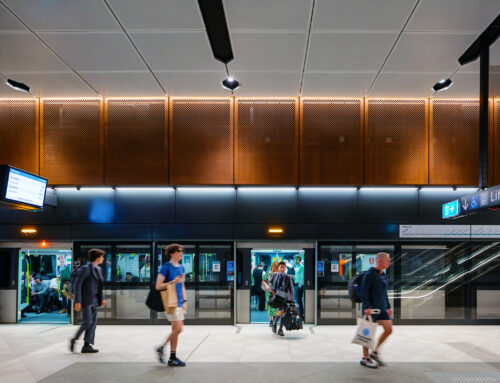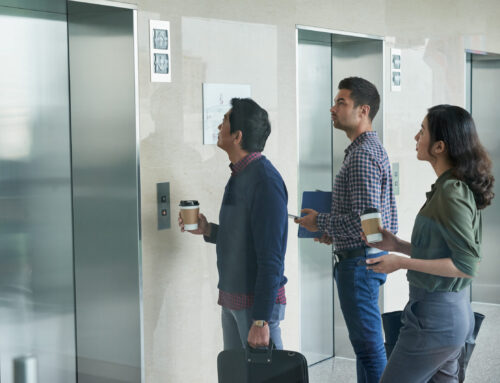It won’t be long before a stand-alone shopping centre or office tower becomes a thing of the past. Developments are expanding up and out, evolving into mixed-use buildings that integrate a combination of retail, residential and commercial. Many are also diversifying into leisure, wellbeing and entertainment.
The recent Transport Oriented Development (TOD) program in New South Wales, Australia, allows developers to build high density housing near a train station. The program is part of the state government’s effort to address the housing shortage.
Under the program, land within a 400 metre radius of 31 stations in the city have been rezoned to allow 6 storey apartment buildings. Apartment blocks with 15 per cent of units set aside for affordable housing will be eligible for a 30 per cent height bonus.
New South Wales is the first state in Australia to implement new legislation of this nature. British Columbia, Canada, is also loosening density restrictions near train stations to encourage housing developments. It remains to be seen if other states, territories and regions will follow.
On paper, these legislative changes makes sense. However, the feasibility of any project depends on being able to keep business operations running in the existing building to keep the money coming in. Business continuity provisions are fundamental to making the numbers add up.
Consider your procurement process
A project can follow several different procurement processes. In our experience, an ‘early contractor involvement’ process is most effective in minimising disruption to business, followed by ‘design and construct’ procurement.
Early contractor involvement (ECI)
This procurement method involves the contractor early on in a project. The contractor is then able to provide valuable input during the initial design stage which can lead to more efficient, value-engineered designs which focus on buildability. Usually, this collaborative approach leads to fewer issues during construction.
The process allows for investigative services early on to understand the reticulation and connectivity of existing services and structure. Providing this information to the design team reduces uncertainty and design variations which subsequently reduces latent risks during construction.
Dilapidation studies on the condition of plant, equipment and structure can also inform the design team of risks. Plant may need replacement or it may still be able to be re-used. This de-risks the project while also realising unforeseen opportunities.
Design and construct (D&C)
In this method of procurement, the contractor manages both design and construction. It complements the ECI process as it continues to keep the contractor closely involved in the design process. This is particularly helpful in complex projects which need careful planning, staging and phased project delivery.
Listen to Peter discuss the key themes in this article with Nathan Dickson, NDY’s Structural and Civil Group Leader
Stage works
Developing strategic construction phases and adhering to a strict timeline is essential to keep the existing building running efficiently. This minimises disruption and facilitates clear communication to customers and tenants.
Our experience tells us the most important considerations include structure and services.
Consider your building services
It’s critical to identify services that must continue to run in order for a centre to continue operating. Some of the key items are smoke exhaust, central cooling, power and fire systems.
Once these have been identified, we recommend carrying out a detailed investigation with the ECI contractor to determine the reticulation and power source of each service. Each service that reticulates through an impacted area will need to be rerouted as part of an enabling-works package to keep business up and running and reduce risk.

Chatswood Chase Redevelopment, New South Wales, Australia
Our enabling works package at Chatswood Chase, New South Wales, Australia included early introduction of temporary smoke exhaust systems as well as building generators, air handling units and essential distribution boards.
Acoustics
Noise and vibration from construction needs to be carefully managed so they’re not disruptive to businesses located around project sites.
Key considerations
Guidelines: every renovation and construction project needs to follow stringent guidelines to meet town planning and development application requirements. These include boundary noise levels during the day, evening and night.
Technical measures: noise is a complex issue to tackle – it changes in each stage of construction; sources are both fixed and mobile; and it’s cumulative. Technical measures to minimise construction noise include choosing quiet equipment, fixed or temporary noise barriers and careful time management.
Administrative measures: these may include restricting operating time of machines, reducing overlapping construction noise sources, limiting any shouting or music on the construction site; planning for construction traffic to access the area at the least sensitive times and in the least disruptive places; and reducing reversing alarms.
Sensitive cases: where there are people very close, for example shoppers, workers or neighbours, it’s wise to carry out continuous monitoring through community liaison and a complaints management procedure.
Air quality
Dust from the construction site needs to be controlled so it doesn’t impact the operating part of the building. While construction hoarding helps with this, the zoning of air circulation systems also needs to be considered so that dust isn’t spread from one zone to another. A cost-effective way to do this can be to blank-off air ducts for the relevant sections.
Fire protection
Fire safety considerations include:
- identifying all areas that need to continue to operate fully and ensuring they have fully functional and compliant fire systems
- assessing existing fire systems to determine if upgrades are required to the smoke detection, emergency warning, fire sprinkler or hydrant systems. Fire services plant and main equipment may need to be constructed in a separate room so that an overnight cutover can be performed from the old plant to the new plant.
- identifying all live reticulation of pipes and cables as soon as ceilings come down so they can be clearly labelled and protected.
- coordinating with the project’s fire engineering team to understand proposed performance solutions and potential impacts to fire services.
Listen to Frazer MacDonald NDY’s Global Leader Fire Engineering, explore the complex integration of fire safety measures across diverse environments through a performance-based approach to design.
Security
Security is vital to public spaces and the following should be considered:
- The CCTV system and recording must continue to operate during the entire construction period.
- Any security cabling in the construction zones must be identified and protected once ceilings are demolished. These are very small cables and can be easily mistaken.
Keep waste to a minimum
A construction site littered with waste materials isn’t going to encourage shoppers to keep coming or the local community to endorse the development. Some ways which can help to minimise waste include:
- incorporating circular economy principles into the construction works, encouraging reuse where possible
- prefabrication of materials
- following a certification framework, for example Green Star, which sets targets for waste
- educating contractors, for example introducing separation of waste onsite with dedicated bins for different types.
Hold onto your community
Mixed-use developments bring the essential, and more, into a single site. However, it’s tenants and customers that make them a success. Nurturing these relationships during major works is essential for a development to survive.
Strategic procurement and staging need to be considered for, above all, structural work and building services. When done right, a development can continue to operate with minimal impact to operations and business. Tenants can keep their people employed and at work, customers can stay loyal to their shopping centre and residents can continue to enjoy where they live.
A solid customer base takes time to build and is easily lost. Now, more than ever, tenants, residents and customers need to be nurtured and rewarded with minimal disruption and continually evolving facilities. That’s how the sticky continue to stick.











